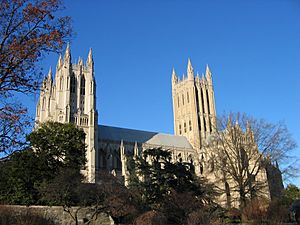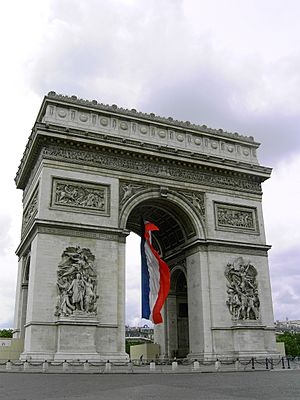Civil religion facts for kids
Civil religion is a concept that describes the shared beliefs and values of a nation. These values are often expressed through public events, symbols like the national flag, and special ceremonies. These events happen on important days or at special places, such as monuments or battlefields. Civil religion is different from official churches, even though church leaders and ceremonies might sometimes be part of it. The idea became well-known in the United States when Robert Bellah used it in the 1960s.
Contents
What is Civil Religion?

The term "civil religion" was first used by Jean-Jacques Rousseau in 1762. He was a French thinker who wrote a book called The Social Contract. Rousseau believed that a modern society needed a strong moral and spiritual base. For him, civil religion was like a "social glue" that helped unite a country. It gave the state a sense of sacred importance.
Rousseau described some simple ideas for civil religion:
- Belief in a God or higher power.
- Belief in an afterlife.
- The idea that good actions (virtue) are rewarded and bad actions (vice) are punished.
- The rejection of religious intolerance, meaning people should not be treated badly for their beliefs.
An Italian historian named Emilio Gentile has studied this idea further. He suggested there are two types of political religions: civil religion and political religion.
Civil Religion in Society
In the study of religion, civil religion is seen as a kind of shared belief system for a whole nation or its political culture. It's like a "folk religion" that everyone in a country might share.
Civil religion is usually practiced by leaders within a society. It's more widespread than a small local folk religion. However, it's not the same as a "state religion." A state religion has official clergy and a formal link with the government. Civil religion is usually practiced by political leaders who are not religious officials.
How Civil Religion is Shown
People who write about politics and society often use the term "civil religion" to describe common patriotic actions. These actions happen in many countries and don't always involve traditional religious beliefs.
Here are some examples of how civil religion is practiced:
- Singing the national anthem at public events.
- Parades or showing the national flag on patriotic holidays.
- Taking oaths of allegiance, like the Pledge of Allegiance in the United States.
- Ceremonies for a new president taking office or a king being crowned.
- Sharing simplified stories about important historical figures, like the Founding Fathers, or big events like famous battles.
- Building monuments to remember great leaders or historic moments.
- Creating monuments for soldiers who died, or holding yearly ceremonies to remember them.
- Showing deep respect for the country, its Constitution, or its leader.
- Publicly displaying the coffin of a political leader who has recently passed away.
Images for kids
-
The emperor Marcus Aurelius performs a public sacrifice.
See also
 In Spanish: Religión civil para niños
In Spanish: Religión civil para niños






